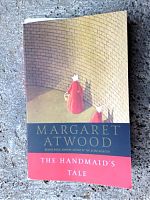
Margaret Atwood
The Handmaid's Tale
One of the few books I remember lying around my house when I was growing up was this one. It was stored inside the TV stand in my parents’ bedroom. The wooden cabinet smelled sharp and fibrous, like old wood that had acquired the smell of something that had been in there for too long. And I relate this book to that smell.
My mom’s copy of The Handmaid’s Tale was a thick mass market paperback and the cover illustration was the same as this one, though it was predominately grey. When I was younger, I probably picked it up and scanned the praise on the back of the book, which probably contained the words “chilling” and “darker interconnections” like this one. I am very happy I didn’t decide to read this book then.
Despite the voracity of my reading, books rarely penetrate my dreams. But The Handmaid’s Tale did—and more than once. I don’t remember what happened in these dreams, but they were chilling. Atwood’s language and images create such a strong idea of the repressive reality of Gilead—a dystopian USA—that just to read it lodged its horrors into my subconscious.
Margaret Atwood describes her Gilead best in this article in The Guardian:
Like any theocracy, this one would select a few passages from the Bible to justify its actions, and it would lean heavily towards the Old Testament, not towards the New. Since ruling classes always make sure they get the best and rarest of desirable goods and services, and as it is one of the axioms of the novel that fertility in the industrialised west has come under threat, the rare and desirable would include fertile women – always on the human wish list, one way or another – and reproductive control. Who shall have babies, who shall claim and raise those babies, who shall be blamed if anything goes wrong with those babies? These are questions with which human beings have busied themselves for a long time.
Offred is one of those women whose sole occupation is to get pregnant, a Handmaid dressed in red. She is part of her Commander’s household that also includes the Commander’s Wife, and two domestics (women dressed in green, called Marthas) and one low-class man, Nick. Most of the Unwomen, those who are not fertile or can’t adjust to life in Gilead for some reason (!) are sent off to the Colonies, or labor camps. Throughout the book, Offred goes back and forth describing life in the new Gilead and how things were before when she had a job, husband, child. Her resistance to the regime is subtle, not like her friend Moira’s, and is through her private thoughts and actions that society has no use for.
One of the main ways Offred asserts herself on her surroundings is by listing off everyday objects in her mind.
A window, two white curtains. Under the window, a window seat with a little cushion. When the window is partly open—it only opens partly—the air can come in and make the curtains move. I can sit in the chair, or on the window seat, hands folded, and watch this.
One effect of Offred’s lists (and they only let up near the end of the book) is that the reader suffers a sense of circumscription along with her and the others forced to live under the puritanical regime. Everyday objects are no longer because what was once everyday, autonomy and agency for women as well as men, is not. Objects are not used in the same way anymore, and so they are not the same. And when the new language of the regime is presented alongside these everyday things, words like Prayervaganza and Econowife and Salvaging, I couldn’t help but to feel the starkness of Offred’s life.
But these lists are also a way for Offred to recreate the objects for herself, of putting her own meaning back into language. What we know about our realities is constructed through language—we tell ourselves stories all the time. It is how we make sense of our surroundings and events, but also it is a way for us to own them, to find a manageable way to think about them. By owning the language, Offred asserts herself on the world in a way that is no longer allowed by the dictating rule. It is her way of being herself. Such quiet recoveries of individuality and dignity are what keep the book hopeful and balance the nightmares.
But a chair, sunlight, flowers: these are not to be dismissed. I am alive, I live, I breathe, I put my hand out, unfolded, into the sunlight.
The Handmaid’s Tale is a timeless story that needs to be told millions of times to millions of people: it is a warning against thought-control, the danger of the herd, the price many pay for the exaltation of the few. But it also reiterates the importance of the individual, and how every little way of forging a resistance still hits the status quo.
· · · · · · · · · · · · · · · · · · · ·